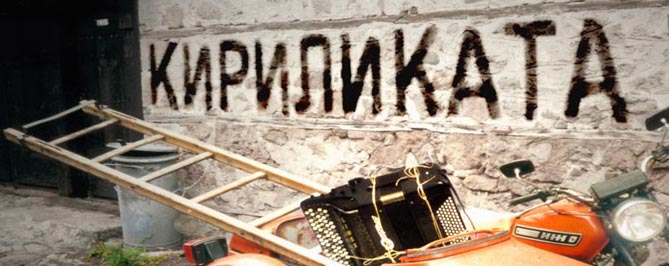
KYRILLIKATA - RezensionenКИРИЛИКАТА / KYRILLIKATA Grekow.ChołołowiczSKUG, Nr. 33, Winter '97/98, Rubrik „Welttöne“Nubenegra plant übrigens die Special Edition „Accordion Tribe“, auf der ob ihrer Brillanz auch die polnischen Bajan-Akkordeonisten Jacek Grekow/Piotr Chołołowicz vertreten sein müßten. Jedoch interpretieren beide mazedonisch-bulgarische Volksmusikmotive (Tarambuka und Gajda sind Zusatzinstrumente, die in dieser, vom „Slawenapostel” Kyrill missionierten Region verwendet werden) auf eher klassische Weise. „Kyrillikata” besticht durch enormen Drive (Vertonung von Roma-Tänzen etc.), doch können die Akkordeonbalgen schon Sekunden später in melancholischer Trauer schwelgen. Ein Juwel, ermöglicht von KulturKontakt und Wiener Integrationsfonds ... Spielräume (Ö1, 10. 12. 1997, 17.30) ... so beginnt die letzte Nummer der Geheimtip-CD „Kyrillikata” ... CD-Besprechung von Tania Lukić Marx (Australien) im Internet (5. Juni 1998)http://www.accordions.com/index/art/cd_98_06_05.shtml I recently received this very interesting and unique CD to review. I'll try to describe ist musical content in brief: Macedonian, Bulgarian, Polish, Russian and Gypsy folk motives and themes are arranged and performed on tzo button (chromatic) accordions. Some other folk instruments are used too (tarambuka, bagpipes) as well as vocals. Rhythms are typically Balcan and South Slavic rhythms: 9/8; 7/8; 6/8. South Slavic motives and rhythms are something I have grown up with, but on this recording they are brought up to a level of very fine art. Technically, all the pieces are performed with great ease along with amazing tone and bellows control. Stylistically, Piotr and Jacek play with a lot of feeling and sensibility, their phrases „breath“ and „sing“ and are so refined that it touches you emotionally. One cannot be critical of their performances. In general Balcan folk music needs a very strong bass pulse and a colourful variety of different rhythms (often Poly-Rhythms). In the pieces where vocals appear it gives them very special feeling of deepness and melancholy. I would even dare to say Slavic melancholy! The vocals are also excellent! At one point these fine musicians used the theme from the last movement of Zolotariev's Sonata No 3, which they do so with tastefulness and style. An absolutely brilliant CD! CD-Newsletter / Frühjahr 1999: Zentralbuchhandlung, 1010 WienVom Geheimtip zum Hit! Motive aus der slawischen Volksmusik, aus Bulgarien, Makedonien, Polen und Rußland gespielt von den polnischen Bajan-Akkordeonisten Jacek Grekow und Piotr Chołołowicz. Balkanmusik – Motive aus der bulgarischen, rumänischen, mazedonischen und russischen Volksmusik – zum Teil Jahrhunderte alt, wurde hier von Jacek Grekow und Piotr Chololowicz grandios, meisterhaft und äußerst kunstvoll in kammermusikalisch erstklassige Bearbeitungen von der Qualität eigener Kompositionen verfaßt. Das ist U-Musik, die in einer solchen Weise als anspruchsvolle und klingende, mitunter mitreißende E-Musik geformt wurde, daß sie eine neue eigene musikalische Klasse beschreibt. Überdies sind die beiden Komponisten und gleichzeitigen Interpreten meisterhafte Könner auf ihren Instrumenten. Die zusätzliche Verwendung von uralten Volksinstrumenten verleiht der ganzen Produktion noch den endgültigen Schliff des Außergewönlichen, mit dem hier ein tatsächliches Unikat vorliegt. Stichworte Virtuose U-Musik, Traditional Kyrillikata ORF MP3:
Review by:Robert Stead (The Classical Free-Reed ) IX 2007
Like Junctions, Kyrillikata plays with Eastern European folk melodies and rhythms. Grekow teams up with accordionist Piotr Chololwicz to present arrangements and original compositions. The two collaborated to create Kyrillikata I and Kyrillikata II-- clearly the most exciting and complex pieces on this CD. Kyrillikata I alternates between chorale-like sections and energetic, percussive dance-like sections. The wordless vocals of Nadja Klincarova are introduced in a sustained chorale section. Nadja's voice has a theremin quality that is haunting. Toward the end of the piece, Grekows puts down his accordion and plays the gajda (an ethnic bagpipe). The gajda functions as an extension of the vocals. Kyrillikata II begins with a chorale section and with vocals again supplied by Klincarova. A theme is then spun off of the chorale and explored by the accordion. In a flash the mood changes—the tempo changes from lento to allegro gioso and an exciting dance theme is played out. If I were to describe the Kyrillakata pieces in one word, that word would be “epic”. The mood changes and stylistic variations found in these compositions are dramatic.
Jacek Grekow, tel.: +48 601 831 048, e-mail:grekowj@wp.pl
|